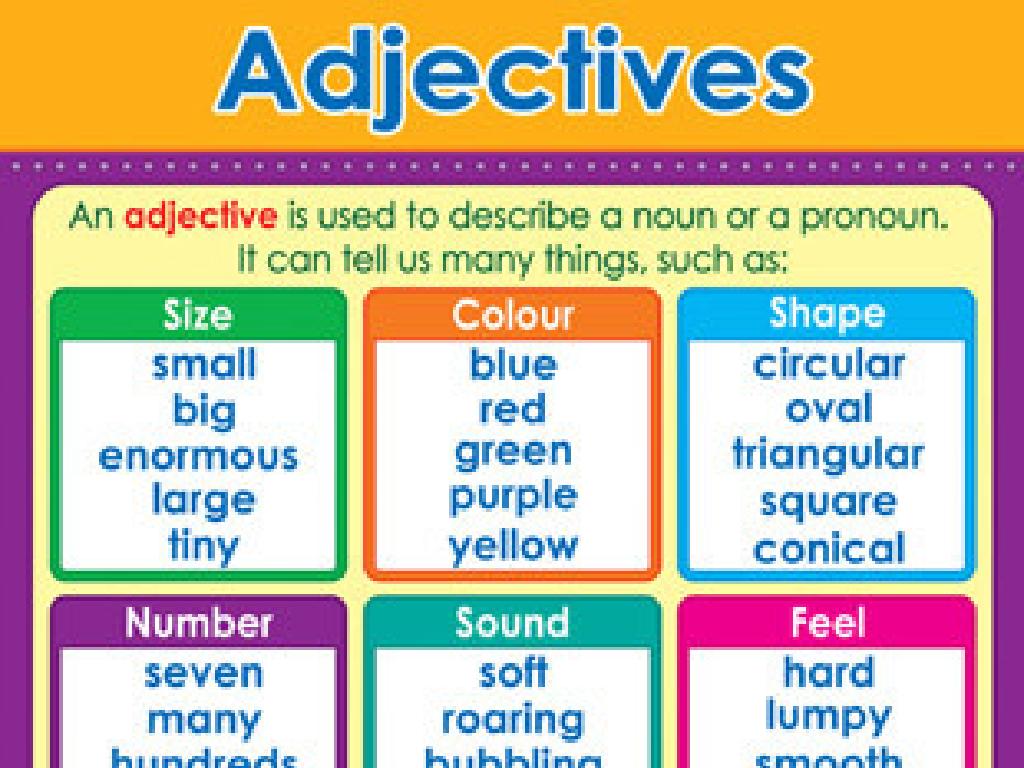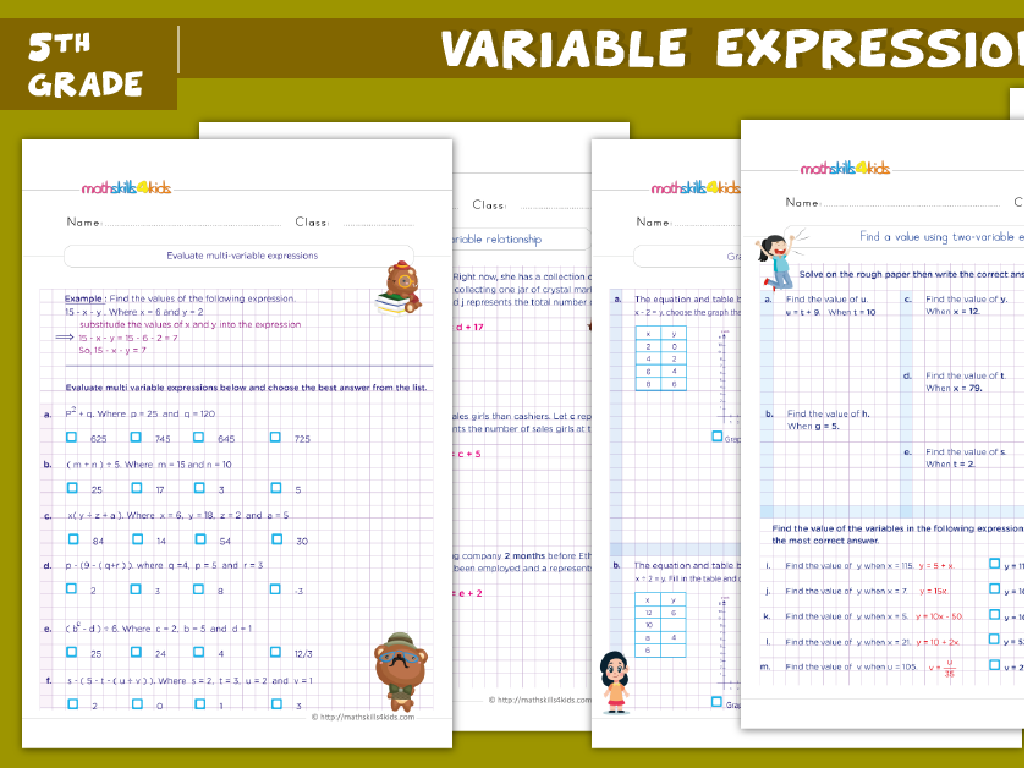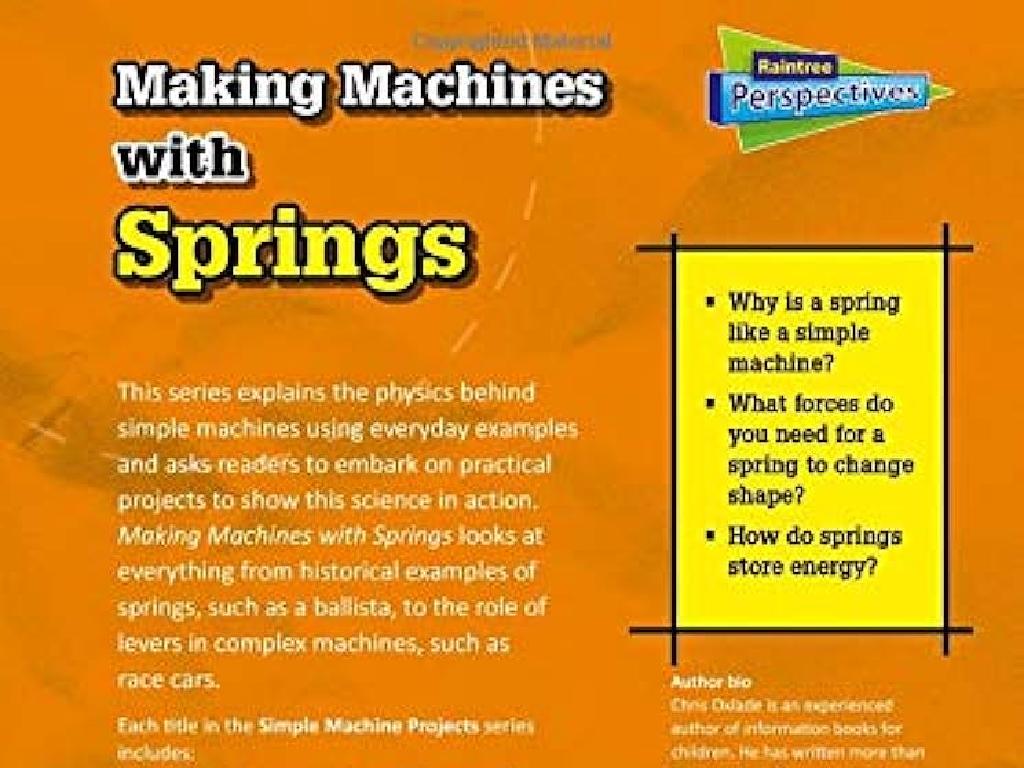Write Variable Expressions: Two Or Three Operations
Subject: Math
Grade: Eighth grade
Topic: Expressions
Please LOG IN to download the presentation. Access is available to registered users only.
View More Content
Writing Variable Expressions: Two or Three Operations
– Grasping algebra’s language
– Algebra uses symbols to represent numbers and operations.
– Focus: Variable expressions
– Learn to write expressions with 2 or 3 math operations.
– Translating verbal to algebraic
– Turn phrases like ‘sum of a number and five’ into ‘x + 5’.
– Mastering multiple operations
– Combine addition, subtraction, multiplication, or division.
|
This slide introduces students to the foundational concepts of algebra, emphasizing the translation of verbal phrases into variable expressions involving two or three operations. The objective is to help students become fluent in the ‘language’ of algebra, enabling them to represent real-world situations mathematically. Encourage students to think of algebra as a tool for solving problems and to practice by converting everyday scenarios into algebraic expressions. Provide examples such as calculating the total cost of items with tax or discounts, or the total distance traveled over several trips. This will help them understand the practical applications of writing variable expressions.
Understanding Variable Expressions
– Define variable expressions
– An expression that includes variables, numbers, and operations
– Differentiate variables and constants
– Variables change, constants stay the same
– Examples of variable expressions
– e.g., 2x + 3, a – 5, 4(y + 2)
– Practice creating expressions
– Use variables to represent numbers in problems
|
This slide introduces the concept of variable expressions, which are fundamental in algebra. A variable expression includes variables (letters representing unknown values), constants (specific numbers), and operations (like addition or subtraction). Start by defining variable expressions and explaining the difference between variables and constants. Provide simple examples to illustrate variable expressions, such as 2x + 3, where ‘x’ is the variable and ‘3’ is the constant. Encourage students to create their own expressions using different variables and operations to solidify their understanding. This will prepare them for solving equations and understanding functions.
Understanding Operations in Variable Expressions
– Review basic math operations
– Addition (+), subtraction (-), multiplication (×), division (÷)
– Explore complex operations
– Exponents (^) raise a number to a power, parentheses ( ) denote priority
– Learn operation symbols
– Symbols guide the order and type of math operations
– Apply operations in expressions
|
This slide is aimed at reinforcing the students’ understanding of basic operations while introducing them to more complex operations used in algebraic expressions. Start by reviewing addition, subtraction, multiplication, and division. Then, explain the use of exponents and the significance of parentheses in altering the standard order of operations. Emphasize the importance of operation symbols as they dictate how numbers and variables interact in an expression. Provide examples of expressions that combine two or three operations, and demonstrate how to solve them step by step. Encourage students to practice writing and interpreting variable expressions with different operations.
Writing Variable Expressions
– Translating words to math
– Turn verbal statements into algebraic expressions, e.g., ‘sum of a number and five’ becomes ‘x + 5’.
– Key phrases for operations
– ‘Sum’ means ‘+’, ‘difference’ means ‘-‘, ‘product’ means ‘*’, ‘quotient’ means ‘/’.
– Practice writing expressions
– We’ll write expressions as a class, like ‘triple a number decreased by two’.
– Understanding expression structure
|
This slide introduces students to the concept of writing variable expressions involving two or three operations. Start by explaining the process of translating words into mathematical expressions. Highlight key phrases that indicate specific operations, such as ‘sum’ for addition or ‘product’ for multiplication. Engage the class in practice exercises where they write expressions based on verbal descriptions. Emphasize the importance of understanding the structure of expressions and the order of operations when more than one is involved. Provide examples and encourage students to ask questions for clarification.
Let’s Practice Writing Variable Expressions
– Expression for a number plus five
– If ‘x’ is our number, the expression is x + 5
– Three times a number minus seven
– For a number ‘x’, the expression is 3x – 7
– A number times the sum of four and itself
– With ‘x’ as our number, it’s x * (x + 4)
|
This slide is a class activity designed to help students practice writing variable expressions involving two or three operations. Example 1 reinforces the concept of addition within an expression. Example 2 combines multiplication and subtraction, while Example 3 introduces the concept of using parentheses to denote the order of operations in expressions. Encourage students to identify the variable, operation, and constants in each example. Provide additional practice problems for students to work on individually, and then review as a class to ensure understanding. Possible activities include peer review of expressions, creating word problems to match expressions, or a game where students write expressions on the board for others to solve.
Group Activity: Expression Creation
– Form small groups for activity
– Create verbal phrases together
– Think of daily life scenarios for phrases
– Translate phrases to expressions
– Use variables and operations to represent phrases
– Present expressions to the class
|
This group activity is designed to encourage collaboration and application of writing variable expressions with two or three operations. Divide the class into small groups and have each group come up with verbal phrases that describe a situation or a problem. Then, guide them to translate these phrases into mathematical expressions using variables, constants, and operations such as addition, subtraction, multiplication, or division. Encourage creativity and ensure that each group understands the importance of the correct order of operations. After the activity, each group will present their expressions to the class, explaining the reasoning behind their translations. This will help students to understand how mathematical expressions can be used to represent real-world situations. Provide feedback and clarify any misconceptions during the presentations.
Class Activity: Expression Challenge
– Write three complex expressions
– Swap and solve expressions with a peer
– Exchange your paper and try solving your classmate’s expressions
– Discuss the phrases and expressions
– Share what the original phrases were and how you turned them into expressions
– Reflect on the activity as a group
– Talk about the challenges and what you learned
|
This activity is designed to engage students with variable expressions through writing, peer interaction, and group discussion. Each student will create three complex expressions involving two or three operations. After writing, they will swap their papers with a classmate to solve each other’s expressions, promoting collaboration and peer learning. Following this, there will be a group discussion where students share the original phrases and how they converted them into mathematical expressions. This will help them understand the thought process behind creating expressions and see different approaches to the same problem. Conclude with a reflection on the activity to reinforce learning outcomes and address any misconceptions. Possible expressions could involve combining terms, using parentheses, and applying different operations like addition, subtraction, multiplication, or division.
Review and Reflect: Variable Expressions
– Recap of today’s lesson
We explored how to write expressions with variables involving two or three operations.
– Significance of variable expressions
Variable expressions are crucial for solving real-world problems in various fields like science and economics.
– Real-life application of expressions
Examples include calculating discounts, determining distances, or predicting outcomes.
– Encouraging critical thinking
|
Today’s lesson focused on writing variable expressions with two or three operations, which are fundamental skills in algebra. Understanding variable expressions is important because they form the basis for more complex mathematical concepts and problem-solving. Students should recognize the practicality of these expressions in everyday life, such as in financial calculations, measuring quantities, or analyzing patterns. Encourage students to think of additional examples where they can apply what they’ve learned today, fostering a deeper connection between mathematical theory and practical use.
Homework: Crafting Variable Expressions
– Write 10 verbal phrases
– Translate to variable expressions
– Convert phrases to expressions like ‘6 less than twice a number x’ becomes ‘2x – 6’
– Include two or three operations
– Use addition, subtraction, multiplication, or division
– Discuss your answers in class
|
This homework assignment is designed to strengthen students’ ability to translate verbal phrases into algebraic expressions, incorporating two or three mathematical operations. Encourage students to think creatively and come up with diverse phrases that reflect real-life situations. Remind them to use a variety of operations to demonstrate their understanding of how to construct expressions. In the next class, students will have the opportunity to discuss their answers, providing a platform for peer learning and further clarification on the topic. As a teacher, be prepared to guide discussions, correct misconceptions, and highlight the importance of precision in mathematical language.





